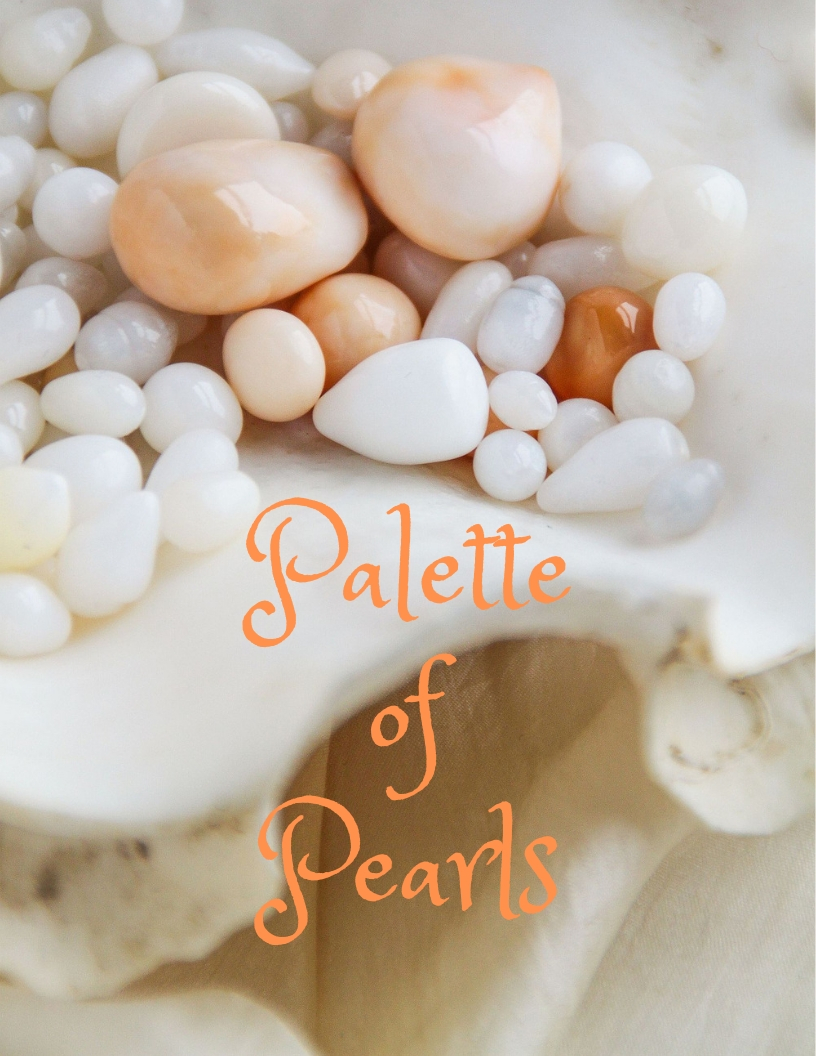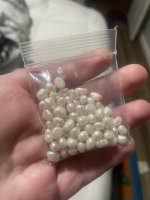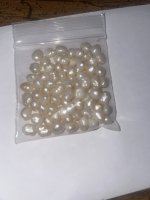S
You are using an out of date browser. It may not display this or other websites correctly.
You should upgrade or use an alternative browser.
You should upgrade or use an alternative browser.
Pearl Dreams
Pearl Enthusiast
- Joined
- Sep 24, 2007
- Messages
- 10,003
Cultured Chinese freshwaters from the early to mid- 1980s I believe. Cristaria plicata (Cockscomb mussel) if I am right.
Strack covers this era, with photos, pp. 421-423.
These pearls are wrinkly.
That being said, usually the Cockscomb mussel pearls are elongated-- "rice krispies" pearls. I have some of those, too.
Or they could be early tissue-nucleated pearls from Hyriopsis cumingii, which came a little later.
Strack covers this era, with photos, pp. 421-423.
These pearls are wrinkly.
That being said, usually the Cockscomb mussel pearls are elongated-- "rice krispies" pearls. I have some of those, too.
Or they could be early tissue-nucleated pearls from Hyriopsis cumingii, which came a little later.
Pearl Dreams
Pearl Enthusiast
- Joined
- Sep 24, 2007
- Messages
- 10,003
I have two photos to share.
1. A strand of small pearls which seem to be from early 1980s and I think may be from the Cockcomb mussel (Cristaria plicaria)
Sorry about the lighting-- daylight desk lamp. This was shot on a white paper background, although it looks blue here. The pearls are white.
I'll try to get a better, daylight photo tomorrow. Edit: See new daylight photo in post below.

2. My mother gave me these pearls Christmas of 1980. They had a gold spring ring clasp and were labeled "Biwa pearl" but I think they are not from Lake Biwa, Japan (which was quite polluted by then) but maybe from the same mussel (Hyriopsis schlegelii), but farmed in China.

1. A strand of small pearls which seem to be from early 1980s and I think may be from the Cockcomb mussel (Cristaria plicaria)
Sorry about the lighting-- daylight desk lamp. This was shot on a white paper background, although it looks blue here. The pearls are white.
I'll try to get a better, daylight photo tomorrow. Edit: See new daylight photo in post below.
2. My mother gave me these pearls Christmas of 1980. They had a gold spring ring clasp and were labeled "Biwa pearl" but I think they are not from Lake Biwa, Japan (which was quite polluted by then) but maybe from the same mussel (Hyriopsis schlegelii), but farmed in China.
Last edited:
S
Supernova
Guest
Either way (mine) not gem quality… I think mine look different than yours.Cultured Chinese freshwaters from the early to mid- 1980s I believe. Cristaria plicata (Cockscomb mussel) if I am right.
Strack covers this era, with photos, pp. 421-423.
These pearls are wrinkly.
That being said, usually the Cockscomb mussel pearls are elongated-- "rice krispies" pearls. I have some of those, too.
Or they could be early tissue-nucleated pearls from Hyriopsis cumingii, which came a little later.
Thank you
Last edited by a moderator:
pearlescence
purveyor of pearls UK/EU
- Joined
- Aug 18, 2007
- Messages
- 4,120
Definitely early Chinese freshwater cultured pearls. Not wild pearls.
Pearl Dreams
Pearl Enthusiast
- Joined
- Sep 24, 2007
- Messages
- 10,003
Here is the daylight photo of the side drilled strand from my earlier post:

And I dug out these loose side-drilled early FWP, which I think are a bit more like yours:


And I dug out these loose side-drilled early FWP, which I think are a bit more like yours:
CortezPearls
PG Forum Admin
- Joined
- Aug 26, 2005
- Messages
- 4,109
I agree!Definitely early Chinese freshwater cultured pearls. Not wild pearls.
S
Supernova
Guest
I see it now, thank youHere is the daylight photo of the side drilled strand from my earlier post:
View attachment 463848
And I dug out these loose side-drilled early FWP, which I think are a bit more like yours:
View attachment 463850View attachment 463851
S
Supernova
Guest
Does anyone know where to get information on wild pearls? There is nothing available online
Pearl Dreams
Pearl Enthusiast
- Joined
- Sep 24, 2007
- Messages
- 10,003
I have the following books and just took a good look at them to check for natural pearls information.
1. There are nearly 300 pages of information about natural pearls in Pearls by Elizabeth Strack-- but few photos you could use to identify them.
I see a copy on Abe Books for about $122 plus shipping from Germany.
https://www.abebooks.com/servlet/SearchResults?an=e.+strack&sortby=2&sts=t&tn=pearls&x=68&y=11
I wish this book could be updated. It's an excellent resource anyway.
2. Also good information in Pearls by Hubert Bari and David Lam. This one has more photos of natural pearls and the shells that produce them, but it's still not a guide on identifying natural pearls. Also from Abe books. Pricey but worth it -- but if you have to choose one, buy Strack.
*** 3. Pearls: A Natural History has a few very good pages of photos of pearl producing mollusks and the pearls they produce. It's downright cheap on Amazon. Not a major source of info on natural pearls, though. But I'd get this if you want to see those pages I mentioned. The few dollars the book costs are well worth it in my opinion as the book is an enjoyable read with great photos.
4. Then there is Pink Pearl: A Natural Treasure of the Caribbean, which is specifically about conch pearls, but that is out of print and very pricey nowadays, and not something that I recommend unless you plan to sell conch pearls.
You could explore the forum we have on books and other resources and maybe find more:
1. There are nearly 300 pages of information about natural pearls in Pearls by Elizabeth Strack-- but few photos you could use to identify them.
I see a copy on Abe Books for about $122 plus shipping from Germany.
https://www.abebooks.com/servlet/SearchResults?an=e.+strack&sortby=2&sts=t&tn=pearls&x=68&y=11
I wish this book could be updated. It's an excellent resource anyway.
2. Also good information in Pearls by Hubert Bari and David Lam. This one has more photos of natural pearls and the shells that produce them, but it's still not a guide on identifying natural pearls. Also from Abe books. Pricey but worth it -- but if you have to choose one, buy Strack.
Pearls by Hubert David Lam Bari - AbeBooks
Pearls by Hubert Bari; David Lam and a great selection of related books, art and collectibles available now at AbeBooks.com.
www.abebooks.com
*** 3. Pearls: A Natural History has a few very good pages of photos of pearl producing mollusks and the pearls they produce. It's downright cheap on Amazon. Not a major source of info on natural pearls, though. But I'd get this if you want to see those pages I mentioned. The few dollars the book costs are well worth it in my opinion as the book is an enjoyable read with great photos.
4. Then there is Pink Pearl: A Natural Treasure of the Caribbean, which is specifically about conch pearls, but that is out of print and very pricey nowadays, and not something that I recommend unless you plan to sell conch pearls.
You could explore the forum we have on books and other resources and maybe find more:
CortezPearls
PG Forum Admin
- Joined
- Aug 26, 2005
- Messages
- 4,109
It will be easier to have a search defined as "natural pearls" as opposed to "wild pearls" (may end up finding a weird dance clubDoes anyone know where to get information on wild pearls? There is nothing available online
CortezPearls
PG Forum Admin
- Joined
- Aug 26, 2005
- Messages
- 4,109
Look...I have this photo of a variety of natural pearl usually known as "Hinge Pearls" (because they are usually found in the thin mantle area very near the hinge area, where both shells meet. They look similar, but when you have enough experience you will rarely -if ever- confuse these with those freshwater pearls:Here is the daylight photo of the side drilled strand from my earlier post:
View attachment 463848
And I dug out these loose side-drilled early FWP, which I think are a bit more like yours:
View attachment 463850View attachment 463851
Pearl Dreams
Pearl Enthusiast
- Joined
- Sep 24, 2007
- Messages
- 10,003
Also check out Kari pearls-- she sells natural pearls. Good images.

 www.karipearls.com
www.karipearls.com

Kari Pearls: Natural Pearls - A Trusted Resource
A trusted source for natural pearls, natural pearl jewelry and all things related...jewelry, information, images, pearl button jewelry, ecards, and videos.
Similar threads
- Replies
- 1
- Views
- 361
- Replies
- 14
- Views
- 956
- Replies
- 11
- Views
- 949


